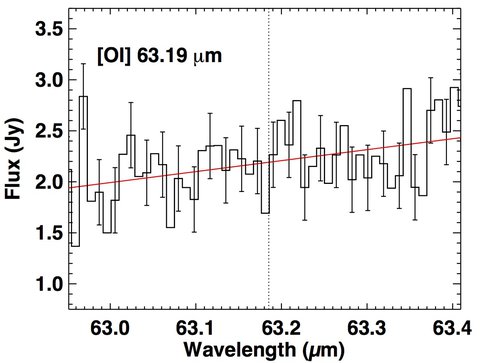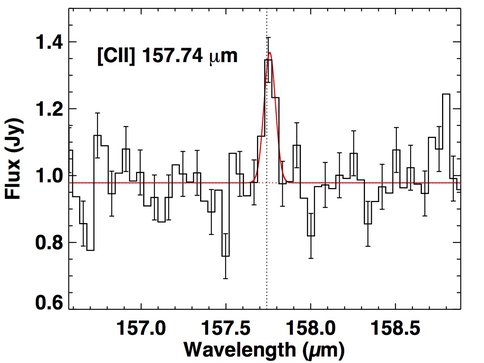2012 Annual Science Report
 NASA Goddard Space Flight Center
Reporting | SEP 2011 – AUG 2012
NASA Goddard Space Flight Center
Reporting | SEP 2011 – AUG 2012
Evolution of Protoplanetary Disks
Project Summary
Drs. Aki Roberge and Carol Grady are pursuing studies related to Theme 2 of the NASA GSFC Astrobiology Node, “From Molecular Cores to Planets: Our Interstellar Heritage.” Over the last year, they have continued work on two Open Time Key Projects for the Herschel Space Observatory, an ESA mission launched in May 2009. Herschel is spearheading the next big advances in our knowledge of planet formation, protoplanetary disk evolution, and debris disks. One project (GASPS) is illuminating the evolution of gas abundances and chemistry in protoplanetary disks over the planet-forming phase. The other (DUNES) has sensitively probed the Sun’s nearest neighbors for signs of cold debris disks associated with extrasolar Kuiper Belts.
Project Progress
Over the last year, many unique new observations of protoplanetary and debris disks have been obtained with the Herschel Space Observatory, a far-infrared/sub-mm telescope launched in May 2009 by the European Space Agency. Drs. Roberge and Grady are Co-Is on a Herschel Open Time Key Project called “Gas in Protoplanetary Systems” (GASPS; PI: William Dent). Dr. Roberge is also a Co-I on another Key Project, “Dust Around Nearby Stars” (DUNES; PI: Carlos Eiroa).
Herschel has provided the first opportunity to sensitively measure gas abundances in a large number of disk systems. To this end, the GASPS project has executed a survey of young stars for far-IR gas emission lines using the PACS spectrograph on Herschel. The GASPS project has observed roughly 250 targets, which were carefully chosen to span a wide range of spectral types. The stellar ages are between 1 million years and a few tens of million years, covering the critical primordial gas dissipation phase into the young debris disk phase. It’s during this phase that protoplanetary disks transform from disks of interstellar material left over from star formation to young planetary systems in the late stages of terrestrial planet formation.
Analysis and modeling of this large dataset is ongoing. We have detected neutral oxygen emission from protoplanetary disks spanning a wide range of parameters, including spectral type, disk mass, and accretion rate. The emission tentatively appears correlated with the strength of the dust continuum emission, but no other parameters as of yet. On the other hand, ionized carbon emission from gas-rich disks is generally weaker than expected based on pre-launch modeling, providing a challenge to current protoplanetary disk thermochemical models. Drs. Roberge and Grady are co-authors on four refereed journal articles published by the GASPS team during this reporting period (Tilling et al. 2012, Lebreton et al. 2012, Donaldson et al. 2012, Meeus et al. 2012).
In addition, Dr. Roberge is leading work on the GASPS observations of the unusual disk system 49 Ceti. This system has the circumstellar dust properties of a debris disk but shows sub-mm CO emission, which is typical of a protoplanetary disk. This led to speculation that the disk was in a rare transitional stage where most but not all of its primordial material had dissipated. Our new GASPS spectra show emission from ionized carbon but no neutral oxygen emission (Figure 1), the first time this has been seen for a disk system observed with Herschel. These observations are hard to explain with primordial-like material and raise the intriguing possibility that the 49 Ceti circumstellar gas is actually coming from a dense swarm of young comets. A paper on this work is in draft form and will be submitted to The Astrophysical Journal by the end of 2012.
Herschel spectra of the unusual 49 Cet disk, showing the regions around the [O I] 63 μm line (left) and the [C II] 158 μm line (right). The rest wavelengths of the lines are marked with dotted lines. No significant O I emission is seen, while the C II line is detected at the ∼ 5σ level. Our best-fitting models for the continuum or the continuum plus emission line are over-plotted with red solid lines. Preliminary modeling of these observations suggests that the disk gas may not be primordial material left over from star formation but may rather arise in a dense swarm of young comets.
Herschel spectra of the unusual 49 Cet disk, showing the regions around the [O I] 63 μm line (left) and the [C II] 158 μm line (right). The rest wavelengths of the lines are marked with dotted lines. No significant O I emission is seen, while the C II line is detected at the ∼ 5σ level. Our best-fitting models for the continuum or the continuum plus emission line are over-plotted with red solid lines. Preliminary modeling of these observations suggests that the disk gas may not be primordial material left over from star formation but may rather arise in a dense swarm of young comets.
The Herschel DUNES project has obtained far-IR photometry of nearby solar-type stars to sensitively probe them for circumstellar dust coming from planetesimals within extrasolar Kuiper Belts. This survey has pushed to unprecedentedly low dust levels and will provide the most complete inventory to date of planetary material around the Sun’s nearest neighbors. These stars will be the primary targets of future efforts to directly detect and characterize potentially habitable terrestrial planets.
The DUNES project has been highly successful. All data have been acquired and every target was detected with the expected sensitivity. Many targets show excess emission coming from cold circumstellar dust, at a rate than higher than the rates seen in earlier surveys with the Spitzer Space Telescope. Notably, DUNES may have discovered a new class of ultra-cold debris disks that present a challenge to theories of planet formation. Dr. Roberge is a co-author on one refereed journal article published by the DUNES team during this reporting period (Eiroa et al. 2011). The full DUNES survey paper is in draft form and will be submitted to Astronomy & Astrophysics by the end of 2012.
In addition to these activities, Dr. Roberge has participated in proposals for follow-up studies of important debris disk systems with ALMA: four in Cycle 0 (Early Science) and five in Cycle 1. Our Cycle 0 proposal to observe the detailed structure of the famous Beta Pic debris disk, and to detect sub-mm CO emission likely coming from comets, was selected for backup observations. The results of the Cycle 1 proposal call have not yet been announced.
Looking at the longer term, warm debris dust coming from planetesimals in extrasolar planetary systems (aka. exozodiacal dust) is likely to be the largest source of noise for future direct observations of habitable planets. Unfortunately, our current knowledge about exozodiacal dust is far from adequate to robustly plan or prepare for a future exoplanet flagship mission (i.e. a New Worlds Mission as envisaged in the Astro2010 Decadal Survey). To assess the situation, Dr. Roberge led a NASA ExoPAG study about the effect of such dust on a generic New Worlds Mission, including an evaluation of our current knowledge and a summary of our expectations for near-term progress (Roberge et al. 2012). Dr. Roberge also participated in a study of the scientific performance of a possible New Worlds Mission concept (Turnbull et al. 2012).
Furthermore, this year Dr. Roberge was selected for the LBTI Key Science Team. LBTI is a NASA-funded instrument for the Large Binocular Telescope, with the primary science aim of probing for exozodiacal dust down to levels relevant for a New Worlds Mission. Science planning for this survey has begun; science observations will begin in a few months and will extend over the next 5 years.
Publications
-
Donaldson, J. K., Roberge, A., Chen, C. H., Augereau, J-C., Dent, W. R. F., Eiroa, C., … Sandell, G. (2012). HERSCHEL PACS OBSERVATIONS AND MODELING OF DEBRIS DISKS IN THE TUCANA-HOROLOGIUM ASSOCIATION. The Astrophysical Journal, 753(2), 147. doi:10.1088/0004-637x/753/2/147
-
Eiroa, C., Marshall, J. P., Mora, A., Krivov, A. V., Montesinos, B., Absil, O., … Wolf, S. (2011). Herschel discovery of a new class of cold, faint debris discs. A&A, 536, L4. doi:10.1051/0004-6361/201117797
-
Lebreton, J., Augereau, J-C., Thi, W-F., Roberge, A., Donaldson, J., Schneider, G., … Woitke, P. (2012). An icy Kuiper belt around the young solar-type star HD 181327. A&A, 539, A17. doi:10.1051/0004-6361/201117714
-
Meeus, G., Montesinos, B., MendigutíA, I., Kamp, I., Thi, W. F., Eiroa, C., … Williams, J. P. (2012). Observations of Herbig Ae/Be stars with Herschel /PACS. A&A, 544, A78. doi:10.1051/0004-6361/201219225
-
Roberge, A., Chen, C. H., Millan-Gabet, R., Weinberger, A. J., Hinz, P. M., Stapelfeldt, K. R., … Bryden, G. (2012). The Exozodiacal Dust Problem for Direct Observations of Exo-Earths. Publications of the Astronomical Society of the Pacific, 124(918), 799–808. doi:10.1086/667218
-
Tilling, I., Woitke, P., Meeus, G., Mora, A., Montesinos, B., Riviere-Marichalar, P., … Spaans, M. (2012). Gas modelling in the disc of HD 163296. A&A, 538, A20. doi:10.1051/0004-6361/201116919
-
Turnbull, M. C., Glassman, T., Roberge, A., Cash, W., Noecker, C., Lo, A., … Bally, J. (2012). The Search for Habitable Worlds. 1. The Viability of a Starshade Mission. Publications of the Astronomical Society of the Pacific, 124(915), 418–447. doi:10.1086/666325
-
PROJECT INVESTIGATORS:
-
PROJECT MEMBERS:
Aki Roberge
Co-Investigator
Carol Grady
Collaborator
-
RELATED OBJECTIVES:
Objective 1.1
Formation and evolution of habitable planets.
Objective 1.2
Indirect and direct astronomical observations of extrasolar habitable planets.

